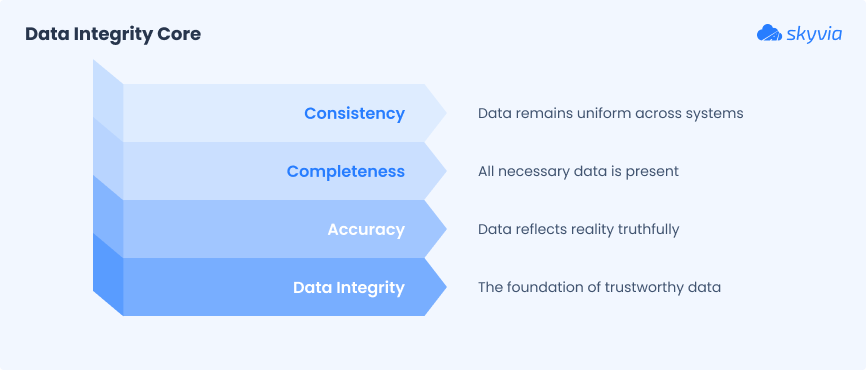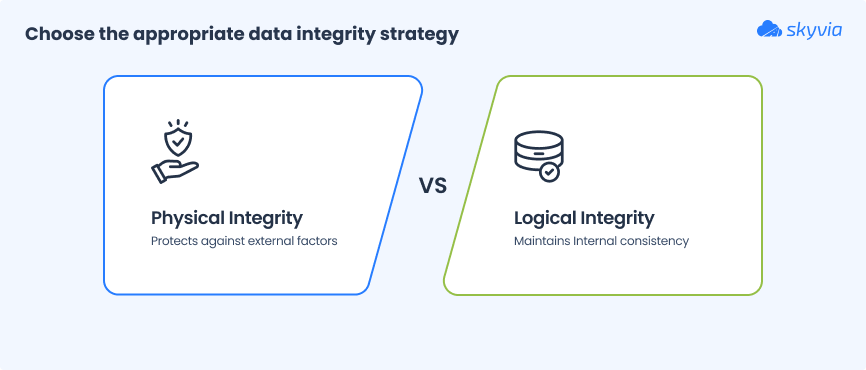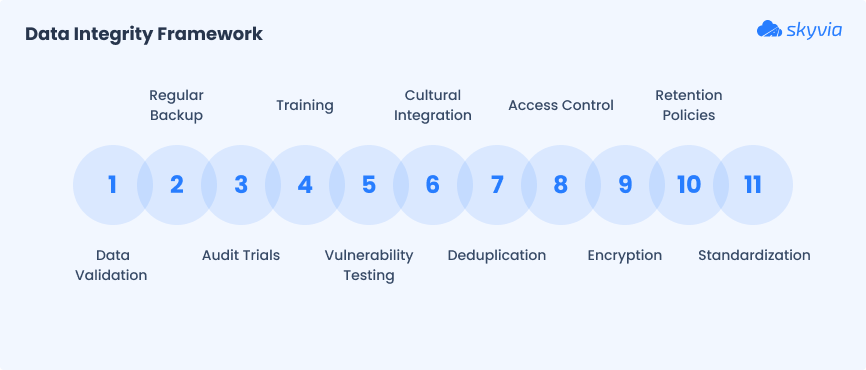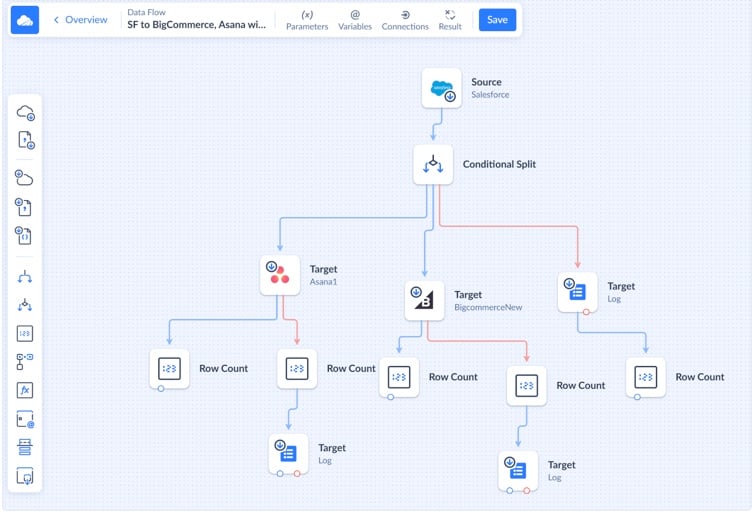Every day, businesses make critical decisions, launching new products, setting revenue targets, and shifting resources based on what they see in dashboards, reports, and syncs between systems.
But here’s the catch: if the data’s wrong, everything that follows is wrong too.
- Maybe a sales report is off because one region didn’t sync.
- Maybe your “best customer” shows up twice with different IDs.
- Maybe your inventory system says you’ve got 100 units, but SAP says 12.
That’s what happens when data integrity breaks down, and it can quietly wreck decisions, operations, and trust across the business.
Data integrity is what makes data trustworthy. It ensures accuracy, consistency, and reliability as the information moves across apps, teams, and workflows.
And it’s not just a technical issue; it’s a business problem:
- Sales is working with stale lead data.
- Finance is reconciling mismatched numbers.
- Ops is chasing ghosts in the inventory.
- Leadership is steering based on dashboards, they hope are right.
Sound familiar?
In this guide, we’re going to break it all down without the buzzwords:
- What data integrity really means.
- The different types (yep, there’s more than one).
- What causes things to go wrong.
- And how to keep data clean, consistent, and decision-ready, even across multiple tools and teams.
Let’s get into it.
Table of Contents
- What is Data Integrity
- The Two Main Types of Data Integrity
- Why Data Integrity is Non-Negotiable for Your Business
- How to Proactively Maintain Data Integrity: An 11-Step Checklist
- The Role of Data Integration in Upholding Data Integrity
- Conclusion
What is Data Integrity?
At its core, this term is about trust. It means data is accurate, complete, and consistent from the moment it enters the system to the moment it gets used in a report, synced to another tool, or archived for audit.
When integrity is intact, data tells the truth. When it’s not, you’re guessing.

Core Principles
There are three things every set of trustworthy data needs:
- Accuracy. The data reflects reality. A sales total is actually the sales total.
- Completeness. No missing fields, records, or broken relationships.
- Consistency. No contradictions across systems or time. Data plays by the same rules everywhere.
If one of these breaks, your integrity starts to slip. If more than one breaks, you’ve got chaos.
Data Integrity vs. Data Quality vs. Data Security
These terms get mixed up a lot, but they’re not the same thing. Let’s clear this up.
- Data Quality is about how useful the data is for its purpose. Is it current? Is it relevant? Does it make sense?
- Data Security is about who can access data and whether it’s protected from breaches or tampering.
- Data Integrity is the umbrella. It covers both quality and security, and adds consistency and accuracy on top. It’s about whether data can be trusted, period.
The Data Lifecycle
Data integrity isn’t a one-time checkbox. It has to be maintained through every phase of the data lifecycle. When data is
- Created or collected.
- Stored, transferred, or transformed.
- Analyzed, reported, archived, or deleted.
The Two Main Types of Data Integrity
Data integrity isn’t just about accuracy; it’s about where and how that accuracy is protected. There are two big categories to know: physical integrity and logical integrity.

Physical Integrity
This term refers to protecting data from factors beyond your control, like hardware failures, power outages, or natural disasters. It’s about ensuring data doesn’t vanish because a server fried or a hard drive gave out.
How to Ensure It:
- Use uninterruptible power supplies (UPS) to protect against sudden power loss.
- Set up automated backups and test them.
- Have a disaster recovery plan that’s not just a PDF in a forgotten folder.
It’s like insurance for data. You hope you never need it, but you’ll be glad it’s there when things go sideways.
Logical Integrity
It’s about keeping data accurate and consistent inside the system. No matter how complex the database is. This is where most of the day-to-day data issues actually happen.
Sub-Types of Logical Integrity
1. Entity Integrity
Prevents duplicate or orphaned records by requiring unique identifiers.
Example: In an e-commerce system, every customer has a unique Customer ID. No duplicates, no confusion, each profile stands on its own.
2. Referential Integrity
Keeps relationships between tables intact.
Example: In an order management system, every order must be linked to a valid Customer ID. If the customer doesn’t exist, the order can’t either; no dangling records.
3. Domain Integrity
Restricts data inputs to valid formats or values.
Example: A web form with a “State” field that only accepts valid two-letter US state codes. No “Californication,” no “XX,” no chaos.
4. User-Defined Integrity
Custom business rules that ensure the data fits your specific requirements.
Example: A company operating under GDPR sets a rule that no customer data can be stored without a recorded consent checkbox; if it’s unchecked, the record doesn’t save.
In other words, logical integrity is the daily grind: keeping data structured, valid, and playing by your rules.
Why Data Integrity is Non-Negotiable for Your Business
Data isn’t just a bunch of numbers and rows. It’s the backbone of how each business runs, how it makes decisions, and how it earns trust. If that foundation’s shaky, everything built on top starts to wobble.
Here’s why data integrity isn’t optional but critical.
Drives Accurate Business Intelligence
You can’t make good decisions on bad data.
When data is clean, consistent, and complete, the dashboards tell the truth, not just a version of it. That means better forecasts, smarter strategy, and fewer “uh-oh” moments.
Builds and Maintains Customer Trust
People expect their data to be safe, and rightfully so.
When you show customers accurate profiles, order history, and preferences, they feel known. When you protect that data, they feel safe. That’s how trust starts and stays.
Ensures Regulatory Compliance
Whether it’s GDPR, HIPAA, or something industry-specific, compliance is built on solid data.
Missing consent fields? Incomplete records? Wrong access controls? That’s how fines happen. Data integrity keeps you aligned and audit-ready.
Improves Operational Efficiency
Data cleanups waste time. Manual fixes slow everything down.
When your systems run on clean data, things just work. Fewer errors, smoother handoffs between tools, and less time spent digging for the “real” number.
Reduces Costs
Dirty data costs in rework, in poor decisions, and in lost deals.
The cleaner the data, the less time (and money) you spend fixing problems that shouldn’t exist in the first place.
How to Proactively Maintain Data Integrity: An 11-Step Checklist
You can’t just “hope” data stays clean. Companies have to build habits and systems that protect the info across every team, every app, and every touchpoint.
Here’s the 11-step checklist for keeping data integrity strong from the ground up.

- Validate Data at Input. Don’t wait until reporting to catch bad data. Add validation rules at the entry point, such as required fields, dropdowns, and format checks, to prevent junk from getting in.
- Eliminate Duplicate Data. Use deduplication tools to clean up existing records and stop new duplicates from sneaking in. No more five versions of the same customer with slightly different emails.
- Back Up Your Data Regularly. Stuff breaks. People make mistakes. Automate backups and have a tested recovery plan, so if something goes wrong, you’re not starting from scratch.
- Control Access to Data. Everyone doesn’t need access to everything. Use least privilege principles to protect sensitive info and avoid accidental overwrites.
- Create an Audit Trail. Track who touched what and when. Audit logs bring accountability and make it easier to trace (and fix) issues when something looks off.
- Encrypt Sensitive Data. The information should be protected in transit and at rest. Encryption keeps personal and financial info safe, whether it’s syncing between tools or sitting in storage.
- Provide Data Integrity Training. Your tech is only as good as the people using it. Train teams on what good data looks like and how to keep it that way.
- Standardize Your Data. Pick a format, stick to it. Use consistent naming, date formats, field structures, and enforce them across systems. Fewer exceptions mean fewer headaches.
- Regularly Test for Vulnerabilities. Run audits. Stress test the setup. Look for weak spots before someone else (or something else) finds them for you.
- Establish Data Retention Policies. Not all info needs to live forever. Define how long to keep records, when to archive, and when to delete. Clean data also means current data.
- Foster a Culture of Data Integrity. Make it everyone’s responsibility, not just IT’s. If the whole org treats data like a shared asset, you’re already way ahead.
The Role of Data Integration in Upholding Data Integrity
You can have the cleanest spreadsheet in the world, but if it’s living in a silo, disconnected from everything else, it’s not doing your business much good.
That’s where data integration becomes a magic stick.
Connecting the Silos
Data lives everywhere: CRMs, ERPs, cloud tools, spreadsheets, and APIs.
Integration platforms like Skyvia connect these sources, so the info can flow freely across systems without breaking or duplicating along the way.
Want to see it in action? Check out this Skyvia overview video showing how to connect apps, databases, and other sources in minutes.
Automating Data Validation and Transformation
Every time you move data, there’s a chance it gets messy: wrong formats, missing fields, misaligned values.
Consider this: manual data entry error rates can reach 1–5%, even among experienced users. Meanwhile, 74% of data breaches in 2023 involved some kind of human error.
Those errors aren’t random. They’re costly and compound.
The fix? Automation.
Skyvia’s Role
Skyvia helps teams maintain integrity with tools that work great despite app-specific quirks:
- Visual data mapping keeps field formats in sync across systems.
- Transformation tools clean and standardize behind the scenes.
- Error handling and logging catch issues before they snowball.
- And it’s all no-code, meaning business users or ops teams, not just developers can manage it.
Curious how others use it? Flip through Skyvia’s case studies or blog for real examples.

Integration tools can validate and transform data on the fly, making sure “California” doesn’t turn into “Cali” or “CA” in three systems.
Check out the Data Flow guide to see how Skyvia handles transformations visually.
Centralizing Data for a Single Source of Truth
When data is scattered, trust erodes.
You don’t know which number is right.
- The one in the report?
- The CRM?
- An Excel someone swears by?
Centralizing data (in a warehouse or unified view) gives your team a single source of truth. One place that everyone trusts. Skyvia’s replication and synchronization tools make this easy.
See It in Action
A quick visual overview shows how easy it is to replicate and sync data (SQL Server → Snowflake or vice versa), turning raw fragments into a unified repository. No coding or heavy lifting required.
Why This Matters
- Unified view. One platform holds all critical data, eliminating confusion over which source is “right.”
- Immediate trust:.When reports always use the same underlying dataset, conversations start from confident footing, not second guessing.
- Scalable setup. Need to add another source? Just point Skyvia to the new tool, and let it integrate beautifully.
Conclusion
Now what? Take five minutes and ask yourself:
- Do we actually trust the numbers in our reports?
- Do we know where our customer data really lives and how it’s changing?
- Are our tools making things clearer, or just layering on more complexity?
If the answers are fuzzy or start with “well… kind of,” then it’s time to tighten things up. Because in a world where every decision is data-driven, you can’t afford to build on shaky ground.
Explore what Skyvia can do for your data integrity.
F.A.Q. for Data Integrity
What are the two main types of data integrity?
Physical integrity protects data from hardware failures and disasters. Logical integrity ensures accuracy and consistency within databases using rules like primary keys and validations.
Why is data integrity so important for a business?
Without it, you risk bad decisions, lost trust, compliance issues, and costly rework. Data integrity keeps your systems aligned and insights reliable.
How can I start improving my company’s data integrity today?
Start with input validation, deduplication, access controls, and backups. Tools like Skyvia, Talend, Informatica, or SAS Data Management can help automate data cleaning, integration, and consistency checks.
Can data be secure but still lack integrity?
Yes. Data can be encrypted and access-controlled, but still be inaccurate, outdated, or inconsistent. Security protects access; integrity protects truth.
What role does data integration play in maintaining data integrity?
Integration connects systems, automates validation, and ensures consistency across sources, creating a single, trusted version of data.


